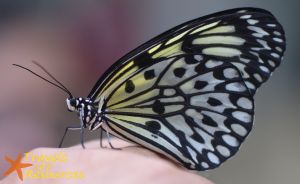 Children may recall the first time they would come across a cartoon with unicorns, fairies, or butterflies. That first encounter would most likely have left them in awe. But as many children grow into adulthood, this sense of wonder beings to fade because many realize that unicorns and fairies are not real.
Children may recall the first time they would come across a cartoon with unicorns, fairies, or butterflies. That first encounter would most likely have left them in awe. But as many children grow into adulthood, this sense of wonder beings to fade because many realize that unicorns and fairies are not real.
Butterflies, on the other hand, are very real. So when adults walk into the Simply Butterflies Conservation Center located in Bohol, some experience that long lost sense of awe all over again.
Table of Contents
Butterflies
Butterflies can be traced as far back as 50 million years. Much of their lives remained a mystery, with the different stages only becoming widespread in the twentieth century. Before this period, it was as if they magically appeared during the blossoming of flowers.

Butterfly
Starting out as an egg, they hatch into caterpillars, which are basically eating machines. Dining primarily on a diet of leaves, they will most likely be the culprit punching holes in your favorite potted plant.
Upon reaching their maximum size, caterpillars will then look for a safe place, which is typically under a leaf, to create a chrysalis around themselves. Then after anywhere between a few days to several weeks, a beautiful butterfly emerges.
It may be interesting to note that moths go through the same growth cycle that butterflies follow. And just in case you are wondering how to tell them apart, one of the easiest ways is to look at their antennae. If they are long single strands of hair, they will most likely be butterflies. But if the pair of antennae are wide or resemble a tiny Christmas tree, then the insect is a moth.
[Like all things in nature, there will be some exceptions as some months will have long antennae.]
Caterpillar
The revelation that butterflies came from disgusting and toxic caterpillars may have had a negative impact on their squeaky clean images during the early spread of information.

Caterpillar
Fortunately, time has a way of healing things. So instead of being repelled by slow-moving, multi-legged creatures, today’s children have developed an interest in caterpillars.

Caterpillar
Perhaps one of the first things that children learn is that caterpillars can be quite colorful. However, parents need to keep an eye on their little ones as the temptation of touch them can result in very painful fingers.
[The general rule to follow around caterpillars is the more colorful it is, the more toxic it will be.]
However, nature has some exceptions to this rule by creating caterpillars that have all of the colors and none of the toxicity. The reason why these harmless caterpillars mimic the bold colors of their poisonous brethren is to fool predators in to leaving them alone.
[I would defer to the experts to tell them apart, though.]
Conservation Center
While I have read and seen toxic and non-toxic caterpillars in book and on videos, nothing beats being able to see them with my own eyes and touch them with my own hands.

Butterfly
This is one of the benefits visitors get when visiting the Simply Butterflies Conservation Center – they have the opportunity to feel the tiny feet of butterflies on their fingers and experience the gentle locomotion of caterpillars in their palms.
And since every tour group is assigned a guide, visitors will almost always come out learning something new from the sanctuary.
You may recall my mentioning caterpillars are not always toxic. Well, this was the first thing taught to us at the Simply Butterflies Conservation Center. For our first lesson, our guide pointed out the different toxic ones safely enclosed in glass cases before placing a couple of non-toxic caterpillars in our hands.

Chrysalis
He then showed us the different types of cocoons, also known as a chrysalises, which caterpillars spin around themselves before transforming into butterflies.
Perhaps the most amazing things we learned has to be that some butterflies can smell like food. As we walked along the path, our guide picked one up and had us smell its abdomen. While smelling something’s bottom may sound weird, the scent it emitted was even weirder because it smelled exactly like chocolate.
[It wasn’t a strong smell but it did resemble chocolate!]

Flower
The final lesson of the tour was to point out that different butterflies are attracted to different flowers. Some butterflies have a long proboscis, which is their tube-like mouth, and can get nectar from long-throated flowers. While some butterflies have a short proboscis, requiring short or tiny flowers.
This is the reason why butterflies are one of the first to disappear when forests are destroyed. Without their preferred flowers, they end up starving. And since butterflies are eaten by Tarsiers, this and other animals up the food, may end up with less and less food.
Final Thoughts
While the Philippine Tarsier is the beloved animal of Bohol, this is the one place where they are unwelcome. Since a Tarsier’s diet consists of insects, caterpillars, worms, and other small creatures, just one can decimate any of the 300 species found in the Simply Butterflies Conservation Center.

Madame Butterflies Ice Cream
Quick flying Dragonflies and fast-grabbing Praying Mantises are also unwelcome because they are voraciously carnivores. Eating in the sky and on the ground means that butterflies and caterpillars have very little places to hide in.
Well, time for me to head out. If you happen to be in Bohol, consider including the Simply Butterflies Conservation Center in your tour. Not only are the butterflies and caterpillars fascinating, the conservation center serves what is probably the best ice cream in the entire island.
Yup, Madame Butterflies Ice Cream has got to be the tastier and creamiest I have ever had in quite a while. Had I known it would be that good, I would have bought more.
[It was only after opening it in the van that I realized my mistake.]
Finally, the Simply Butterflies Conservation Center charges a small entrance fee of PhP 40 per person. This is used to help feed the insects and keep the place clean. In our case, we tipped our guide as we were very happy with the things he taught us. If you want to do the same, PhP 50 and above would be greatly appreciated, especially if you are a big group.
Must Do’s
- Follow the instruction of your guide.
- Bring a Macro Lens if you have one.
- Use a flash to illuminate the colorful wings of the butterflies.
Must Don’ts
- Be careful where you step and you might crush a butterfly.
- Do not grab any butterflies yourself, you fingers might tear off their wings.
- Make sure you don’t have a cold so you can smell the chocolate.


Comments are closed